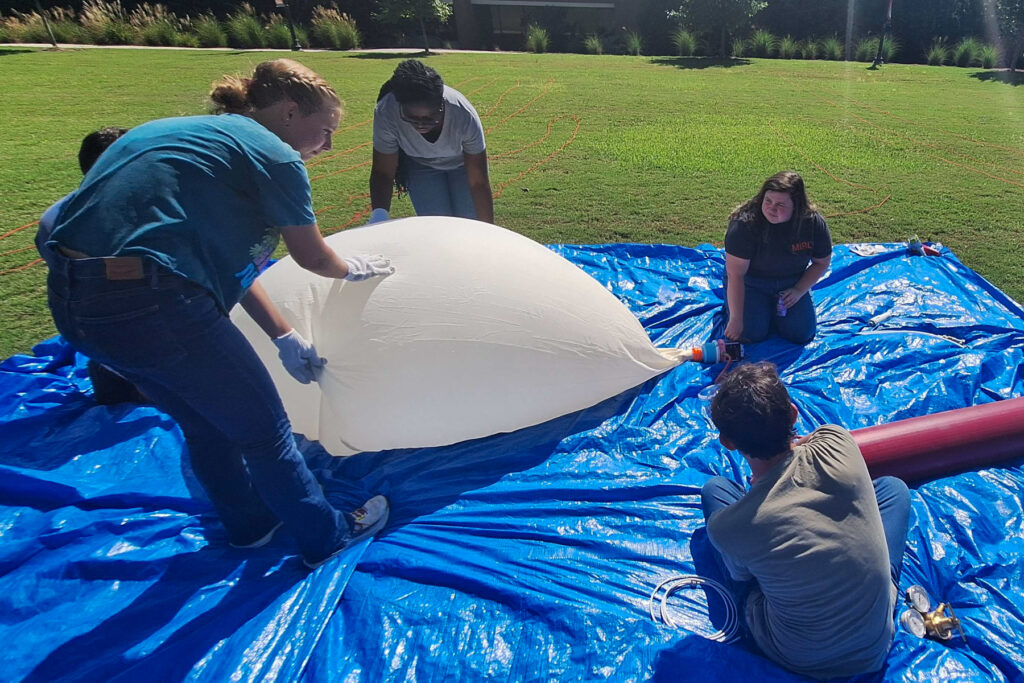
A Mercer University team of engineering students will launch a high-altitude balloon into near space during the Oct. 14 annular solar eclipse, as part of a nationwide NASA mission. In an annular solar eclipse, the sun’s outer edges can be seen as a bright ring around the moon.
The team will broadcast on NASA TV live, high-resolution video of the eclipse and collect data that will help scientists measure the eclipse’s disturbance to Earth’s atmosphere, said Dr. Anthony Choi, professor of electrical and computer engineering.
The mission is part of the Nationwide Eclipse Ballooning Project, which includes 75 participating institutions and over 750 students. Mercer is among about 30 teams participating in the engineering track, Dr. Choi said.
On the day of the annular solar eclipse, the Mercer team will launch a helium-filled, high-altitude balloon carrying science and engineering equipment from somewhere northwest of San Antonio, Texas, up to about 90,000 feet, said team lead Ashley Tyler, a senior majoring in computer engineering. Ten students will participate in the launch.
The equipment on the balloon will collect data including GPS location, altitude, air pressure and more, she said. Sensors also will measure gravity waves, which are circular ripples created by a disturbance in gravity, similar to a pebble being thrown into a pond, Dr. Choi said.
“We’re going to try to measure the disturbance of the annular eclipse on our atmosphere, so we’re trying to measure the pressure waves that we see as the moon casts a shadow over the earth,” he said.
Scientists will analyze data from the Mercer balloon and others launched across the entire path of the eclipse.
“The idea is to be able to see the wave traveling as the eclipse is happening,” Dr. Choi said.


The project allows students to engage in high-level research and engineering concepts. Students learn to work across engineering disciplines, including mechanical, electrical and computer science, as well as work on a real-life mission, said Dr. Humin Kim, assistant professor of electrical and computer engineering.
It also teaches students to work collaboratively across teams, Dr. Choi said.
About a dozen students have worked on the project in various capacities, from attending workshops to participating in virtual and hands-on training to launching a tethered balloon for practice. Tyler said she’s learned about leadership, research and other engineering fields by working on the project.

Students will participate in a similar mission during the April 8 total solar eclipse, in which the moon will completely block the face of the sun.
Mercer’s participation was made possible by a $20,000 grant from the Nationwide Eclipse Ballooning Project, which is funded by the NASA Science Mission Directorate Science Activation program and the NASA Space Grant Network. Dr. Choi and Dr. Kim also received $6,314 from the Georgia Space Grant Consortium and strong support from the Provost Office, School of Engineering and Student Government Association.
In 2010, Dr. Choi began receiving NASA grant funding for outreach projects and research and systems work. In 2017, Dr. Choi, in partnership with NASA, led a team of 23 students in launching a high-altitude balloon from Sunset, South Carolina. The team live streamed video and collected experimental data from near space during the first total solar eclipse in the continental U.S. in 38 years.
That project jump-started the High-Altitude Research Platform, or HARP, initiative at Mercer, which provides a low-cost way for K-12 schools and other universities to gain access to near space for experimentation and data collection. The goal is for students to look at space as something they can easily gain access to, touch and feel.
Dr. Choi said he hopes the National Eclipse Ballooning Project helps rebuild interest in the HARP initiative, so Mercer can provide balloon launch services and outreach for HARP.









